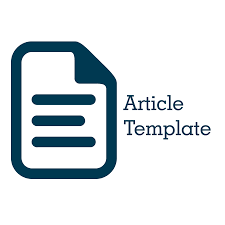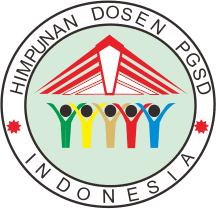Pengaruh penggunaan media kartu gambar berbasis augmented reality (ar) terhadap keterampilan menulis puisi peserta didik kelas iv sekolah dasar
Abstract
Abstract.This research purpose is to identify the effect of using augmented reality (AR)-based picture card media on the poetry writing skills of fourth grade elementary school students. Quantitative research method Quasi Experiment Nonequivalent Pretest-Posttest Control Group design. The research population was public elementary schools in Laweyan sub-district, the sample was determined by Cluster Random Sampling. The data collection technique was a poetry writing skill test. Instrument validity test with Expert Judgment and Alpha Cronbach reliability test. Research prerequisite tests: Shapiro Wilk normality test, Levene homogeneity test, and T-test balance test. Hypothesis testing with Independent Sample T-test. The average post-test score showed that the control group was 73.04 and the experimental group was 80.77. The results of the percentage of achievement of the experimental group's poetry writing skills indicators were higher than the control group in the aspects of theme, rhyme, majas, diction, and imagery. The results of the hypothesis test value (sig.) 0.002 <0.05 (H0 rejected), there is a significant effect of using augmented reality (AR) based picture card media on poetry writing skills. The effect occurs due to the use of media in learning to write poetry. This media can visualize 3D interestingly so that it helps students understand the material more concretely, provides new experiences, stimulates creativity, vocabulary, imagination, interaction, and learning motivation. The implication of the research is that it is an important input for teachers in considering the use of creative and innovative media so that the provision of stimulation has an effect on learning outcomes.
Abstract.This research purpose is to identify the effect of using augmented reality (AR)-based picture card media on the poetry writing skills of fourth grade elementary school students. Quantitative research method Quasi Experiment Nonequivalent Pretest-Posttest Control Group design. The research population was public elementary schools in Laweyan sub-district, the sample was determined by Cluster Random Sampling. The data collection technique was a poetry writing skill test. Instrument validity test with Expert Judgment and Alpha Cronbach reliability test. Research prerequisite tests: Shapiro Wilk normality test, Levene homogeneity test, and T-test balance test. Hypothesis testing with Independent Sample T-test. The average post-test score showed that the control group was 73.04 and the experimental group was 80.77. The results of the percentage of achievement of the experimental group's poetry writing skills indicators were higher than the control group in the aspects of theme, rhyme, majas, diction, and imagery. The results of the hypothesis test value (sig.) 0.002 <0.05 (H0 rejected), there is a significant effect of using augmented reality (AR) based picture card media on poetry writing skills. The effect occurs due to the use of media in learning to write poetry. This media can visualize 3D interestingly so that it helps students understand the material more concretely, provides new experiences, stimulates creativity, vocabulary, imagination, interaction, and learning motivation. The implication of the research is that it is an important input for teachers in considering the use of creative and innovative media so that the provision of stimulation has an effect on learning outcomes.
Kata kunci: picture card media, augmented reality, poetry writing skills, elementary school
Keywords
Full Text:
PDFReferences
[1] D. Setiawan, W. Sopandi, and T. Hartati, “Kemampuan menulis teks eksplanasi dan penguasaan konsep siswa sekolah dasar melalui implementasi model pembelajaran RADEC,” Prem. Educ. J. Pendidik. Dasar dan Pembelajaran, 9(2), p. 130, 2019, doi: 10.25273/pe.v9i2.4922.
[2] J. L. Sze and J. Southcott, “Pencil or Keyboard? Boys’ Preferences in Writing,” Qual. Rep., 25(7), pp. 1946–1959, 2020, doi: 10.46743/2160-3715/2020.4621.
[3] R. D. Pradopo, Pengkajian Puisi, 11th ed. Yogyakarta: UGM Press, 2009.
[4] Prihatin, S. Y. Slamet, and T. Budiharto, “Studi Hubungan Antara Penguasaan Kosakata dan Kemampuan Penalaran dengan Keterampilan Menulis Puisi Pada Peserta Didik Kelas IV Sekolah Dasar,” J. Pendidik. Indones., 6(4), 2022, doi: https://doi.org/10.20961/jpiuns.v6i4.60188.
[5] D. Rahmawati and T. Citrawati, “DIDAKTIS Jurnal Pendidikan Bahasa dan Sastra Indonesia Jenis Kesulitan Menulis Puisi bagi Peserta Didik di Sekolah Dasar,” 1(2), pp. 45–50, 2023, doi: 10.33096/didaktis.v1i2.299.
[6] F. N. Ajmiy and N. K. Umam, “Keterampilan Menulis Puisi Bebas Pada Mata Pelajaran Bahasa Indonesia Kelas IV MI,” J. Elem. Edukasia, 6(4), pp. 1654–1667, 2023, doi: 10.31949/jee.v6i4.6984.
[7] R. Jannah, I. B. K. Gunayasa, and M. Tahir, “Analisis Kesulitan Menulis Teks Puisi Peserta Didik Kelas IV SDN 1 Dasan Baru Tahun Ajaran 2020/2021,” J. Pendidik. Dasar, 2(2), pp. 121–126, 2022.
[8] P. Rahayuningsih, W. Hidayah, C. N. Primar, and N. Nurmelia, “Fungsi dan Peran Media Pembelajaran Sebagai Upaya Peningkatan Kemampuan Belajar Siswa,” Educ. J. Penelit. Ibnu Rusyd, 2(1), 2022.
[9] A. P. Wulandari, A. A. Salsabila, K. Cahyani, T. S. Nurazizah, and Z. Ulfiah, “Pentingnya Media Pembelajaran dalam Proses Belajar Mengajar,” J. Educ., 5(2), pp. 3928–3936, 2023, doi: 10.31004/joe.v5i2.1074.
[10] H. Hanikah, A. Faiz, P. Nurhabibah, and M. A. Wardani, “Penggunaan Media Interaktif Berbasis Ebook di Sekolah Dasar,” J. Basicedu, 6(4), pp. 7352–7359, Jun. 2022, doi: 10.31004/basicedu.v6i4.3503.
[11] N. Nursabra, S. Syamsinar, N. F. Nurchalis, and R. Nuralima, “The Use of Augmented Reality Flashcard in Enriching Students’ vocabulary,” Cokroaminoto J. Prim. Educ., 6(1), pp. 73–81, 2023, doi: 10.30605/cjpe.612023.2493.
[12] R. Jannah and R. N. Oktaviani, “Pengaruh Penggunaan Media Augmented Reality Terhadap Kemampuan Literasi Numerasi Digital Pada Pembelajaran Matematika Materi Penyajian Data Kelas V MI At-Taufiq,” J. Ibriez J. Kependidikan Dasar Islam Berbas. Sains, 7(2), pp. 123–138, 2022, [Online]. Available: https://ibriez.iainponorogo.ac.id/index.php/ibriez/article/view/283
[13] Z. Makhasin, W. Sri Utami, U. Teknologi Yogyakarta, J. Siliwangi Jl Ring Road Utara Jombor Sleman, and D. Yogyakarta, “Pemanfaatan Teknologi Augmented Reality dalam Pembelajaran Tata Surya Berbasis Android,” JUKI J. Komput. dan Inform., 5(2), pp. 301–313, 2023, [Online]. Available: https://ioinformatic.org/index.php/JUKI/article/view/397
[14] T. Yuliono, Sarwanto, and P. Rintayati, “Keefektifan Media Pembelajaran Augmented Reality Terhadap Penguasaan Konsep Sistem Pencernaan Manusia,” JPD J. Pendidik. Dasar, 9(1), pp. 65–84, 2018.
[15] D. S. C. Saputri, “Penggunaan Augmented Reality untuk meningkatkan penguasaan kosa kata dan hasil belajar,” Jutisi, 6(1), pp. 1357–1366, 2017.
[16] Y. Kırkgöz, “Exploring Poems to Promote Language Learners’ Creative Writing,” Procedia - Soc. Behav. Sci., 158, pp. 394–401, 2014, doi: 10.1016/j.sbspro.2014.12.106.
[17] K. Kähmi, “Advances in Poetry Therapy,” Scriptum, vol. 4, no. 2013, pp. 30–43, 2015.
[18] F. N. S. Utami, R. Winarni, and M. I. Sriyanto, “Analisis pembelajaran menulis puisi peserta didik kelas IV sekolah dasar,” Didakt. Dwija Indria, 11(6), p. 43, 2023, doi: 10.20961/ddi.v11i6.77086.
[19] A. Trisiana, “Penguatan Pembelajaran Pendidikan Kewarganegaraan Melalui Digitalisasi Media Pembelajaran,” J. Pendidik. Kewarganegaraan, 10(2), p. 31, 2020, doi: 10.20527/kewarganegaraan.v10i2.9304.
[20] M. Masri and E. Lasmi, “Perancangan Media Pembelajaran Tata Surya Menggunakan Teknologi Augmented Reality Dengan Metode Markerless,” J. Electr. Technol., vol. 3, no. 3, pp. 40–47, 2018, [Online]. Available: https://jurnal.uisu.ac.id/index.php/jet/article/view/1118
[21] Syarifuddin and E. D. Utari, “Media Pembelajaran (Dari Masa Konvensional Hingga Masa Digital),” Hikmah, 18(1), pp. 64–80, 2022.
[22] I. Arifin, A. Asdar, and R. Rahmania, “Hubungan Penguasaan Kosakata Dan Minat Membaca Dengan Keterampilan Menulis Puisi Pada Peserta Didik Kelas V Sekolah Dasar Di Kabupaten Pinrang,” Bosowa J. Educ., 4(1), pp. 37–43, 2023, doi: 10.35965/bje.v4i1.3876.
[23] R. W. Irawan, F. Nugrahani, and B. Sudiyana, “Pengembangan Media Flash Card dalam Penguatan Pembelajaran Keterampilan Menulis Teks Deskriptif Siswa SMP,” Alf. J. Bahasa, Sastra, dan Pembelajarannya, 6(2), pp. 32–42, 2023, doi: 10.33503/alfabeta.v6i2.3515.
[24] I. F. Laily, “Peningkatan Kemampuan Menulis Puisi Dan Kemampuan Imajinatif Siswa Sekolah Dasar Melalui Metode Imajinasi Dengan Menggunakan Media Gambar Fotografi,” Pedagog. J. Pendidik. Guru Sekol. Dasar, 4(2), pp. 79–92, 2016, [Online]. Available: https://jurnal.unismabekasi.ac.id/index.php/pedagogik/article/view/1287
[25] A. Asnidar, “Upaya Meningkatkan Kemampuan Menulis Puisi Bebas melalui Metode Inkuiri Siswa Kelas VIII SMP Negeri 6 Medan,” MEDAN MAKNA J. Ilmu Kebahasaan dan Kesastraan, 12(1), 2014.
[26] T. Suhati, B. Hendrawan, and R. Permana, “Pengembangan Media Pembelajaran SOLCAR Berbantuan Assemblr Edu Untuk Meningkatkan Hasil Belajar IPA Materi Sistem Tata Surya Kelas VI Sekolah Dasar,” JERUMI J. Educ. Relig. Humanit. Multidiciplinary, 1(2), pp. 108–115, 2023, doi: 10.57235/jerumi.v1i2.1248.
[27] I. Mustaqim, “Pengembangan Media Pembelajaran Berbasis Augmented Reality,” J. Edukasi Elektro, 1(1), 2017, [Online]. Available: http://journal.uny.ac.id/index.php/jee/
Refbacks
- There are currently no refbacks.



